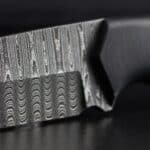Coating: ATP-641, Turco, or similar high temperature anti-scale/decarburization coatings can be used in replace of foil to reduce scale or surface decarburization. Preheating: Heat oven to 1300°F and place material in oven. Austenitizing (High Heat): Heat slowly (400°F a/hr) from the preheat to 1475-1500°F (802-816C) Soak for 30 minutes for the first inch (25.4 mm) […]
Archives for September 2018
How to Harden Stainless (Aeb-L) Damascus
Begin with your Damascus product wrapped as tightly as possible in .002 SST foil. Use double folds on all sides to ensure a tight seal. Preheat your furnace to austenitizing temperature – 1,925 degrees Fahrenheit. Place your wrapped piece in the furnace. Allow your furnace to cycle back up to austenitizing temperature. Soak your piece […]
What’s the proper technique for etching Damascus?
How to Etch Stainless and Carbon Damascus Steel By taking your time and learning how to etch stainless Damascus and carbon Damascus steel properly, you’ll avoid problems like spots in your finished product. Damascus etching is done with a mixture of Ferric Chloride and Distilled Water, we use a 50/50 mixture. Before you begin, check […]
Why am I getting little spots on my Damascus after etching?
There are a few reasons you might see spots on your Damascus after etching. Let’s troubleshoot. If your Damascus was ground too fast, it may have gotten too hot and the pores in the metal may have closed, which prevents the acid from penetrating correctly. This is most common on thin blades, like kitchen knives, […]
Do you offer a stainless Damascus that doesn’t require heat treatment?
Yes. We offer twisted Damascus rods, raindrop billets, ladder billet, typhoon billets, and random billets in 304/316 stainless, which doesn’t require heat treatment.
Are delaminations and voids normal for Damascus steel?
Yes and No. It’s a common misconception that working with Damascus means that you’re just going to have to accept a certain amount of imperfections. Truth is there is just a bunch of cheap, poorly made damascus out there that’s giving the good stuff a bad reputation. Damascus takes a lot of attention to do […]
Does the Damascus pattern change as I grind into it?
There are a few factors that determine if and how much a pattern will change when ground or machined. First is how aggressive your angles and cuts are. For example the bevel on a kitchen knife is much less than the angle of the bevel on a hunting knife. This means that the pattern will […]
Do I need to run my mill or lathe slower than normal to avoid delamination?
This really depends on where you’re purchasing your Damascus and Mokume-Gane. In our opinion, you shouldn’t have to worry about the material ripping apart and potentially damaging your machine, or, worse, causing injury. When Damascus is made correctly, the layers fuse and cannot be torn apart. While it’s always possible for a smith to have […]
Is your Damascus hardened or annealed?
We carefully anneal each piece of Damascus before it’s sent to you. This step is often overlooked, but annealing softens the steel for easier working. If you would like your Damascus hardened to a certain rockwell hardness, let us know and we can put you in contact with one of our professional heat treat vendors. […]
What’s the average wait time for an order?
The average wait time for most orders is 2 to 3 weeks. Your wait will vary depending on the size of your order and our current workload. For more specific wait time estimates, call our office.
